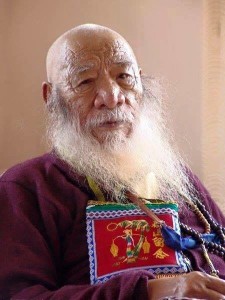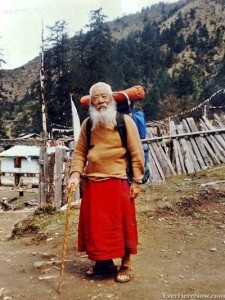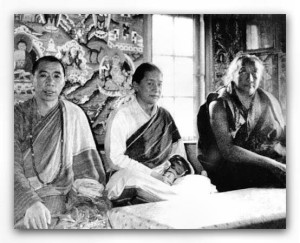Kyabje Chatral Sangye Dorje Rinpoche
January 16th, 2016 | Published in NEWS
Chatral Rinpoche, Sangye Dorje (1913–2015) passed into parinirvana in Yangleshö, Nepal on December 30. He was a Dzogchen master, a reclusive yogi, a great protector of the Dharma and of all beings, revered for his great realization and strict discipline.
Rinpoche was born in June of 1913 in the Nyak Adzi Valley in Kham, Tibet. At the age of eight, he went to Kathok Monastery to study with Khenpo Ngawang Palzang (1879-1941) and never returned home again. During the course of the next 25 or 30 years he completed 14 ngondros and practiced intensively.
Chatral Rinpoche’s root guru, Khenpo Ngawang Palzang, gave him many teachings and transmissions—particularly of the Longchen Nyingthig tradition. He bestowed upon Rinpoche the name Chatral Sangye Dorje, which means “Indestructible Buddha who has Abandoned all Mundane Activities.” Rinpoche studied with other masters at Kathok Monastery as well, including Katkok Situ, and with the great Khyentse Chökyi Lodrö (1893-1959).
He traveled to Central Tibet where he studied with the great female terton Sera Khandro and received the complete empowerments and transmission of her lineage. He also received transmissions of the terma cycle of Terton Dudjom Lingpa (1835-1903) from the Terton’s son Dorje Dradül (1891-1959), and spent over a year studying and assisting Dudjom Jigdral Yeshe Dorje.
He was appointed to be the head spiritual teacher for the Regent Reting Rinpoche, the political ruler of Tibet. The huge amount of attention drawn to him through this prestigious position was a distraction from his practice, and he retreated back to the mountains where he spent the next several years in solitary meditation in the most austere conditions.
Rinpoche, traveled exclusively on foot and refused a horse when offered. He stayed only in hermitages, caves, or in his small tent to avoid involvement with householders and worldly preoccupations.
He was the heart disciple and Vajra Regent of the late Dudjom Rinpoche and is the chief lineage holder for three main traditions in the Nyingma School: Dudjom Tersar, Sera Khandro, and Longchen Nyingthig, and, in particular, the lineage that descends through Jigme Lingpa’s heart son Jigme Gyalwe Nyugu and then on to Patrul Rinpoche.
In the late 1950’s, Chatral Rinpoche moved to Bhutan, and traveled to the neighboring Himalayan region of Darjeeling, where he restored a simple temple and turned it into a three-year meditation retreat center for Longchen Nyinthig practice. He married when he was fifty-two and had three daughters.
In 1968, Chatral Rinpoche met with the Trappist monk Father Thomas Merton, as recounted in his book “Asian Journals”. Father Thomas Merton remarked that he was “the greatest man I ever met.”
Chatral Rinpoche was especially well known for his advocacy of vegetarianism and his yearly practice of ransoming the lives of thousands of animals, and for blessing and releasing millions of fish into the Indian Ocean. He established numerous three-year retreat centers throughout the Himalayas, including in Pharping, Yolmo and Darjeeling. He never traveled to the West, and any offerings he received were used exclusively for animal release.
This text was taken from a video of Sangyum Kamala and two extensive biographies http://erik-pema-kunsang-a-live-biography.blogspot.dk/p/chatral-sangye-dorje-namo-gurubhya.html and http://www.compassionateaction.info/bio.php
Kyabje Chatral Rinpoche: ”There is no better prayer or worship we can offer to Lord Buddha than being thoughtful, kind, compassionate and abstaining from taking the life of any fellow human being, animal, bird, fish or insect. Trying to save any life from imminent danger, or trying to mitigate their pain and suffering, is one step further in the active practice of loving other living beings.”




